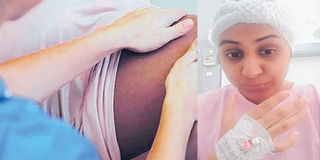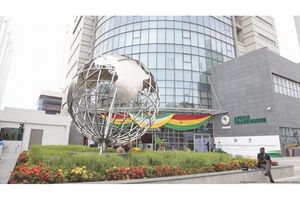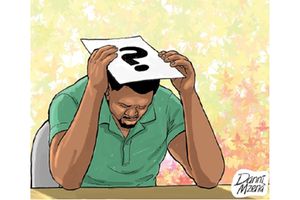Living with stones in my body

One night in early September 2017, 11.00 pm I woke up with cold sweat on palms and forehead. I assumed it is just another pregnancy outcome. I had just entered my third trimester.
I felt pain with each deep breath and back aches. And there was that hot, tight, sore spot right above my belly. I woke my husband up, telling him I can’t breathe.
I press hard on the center of the pain, close my eyes tight and wait. My heartbeat echoes gently up my fingertips. Is it a heart attack?
“What’s going on,” I think aloud. The sweat’s drying, and I can fill my lungs without doubling over from the pain. It’s 10 minutes past 11, I’m okay.
A week later, at 1.00 am, repeat of above. I am not okay. The pain lasted for more than 10 minutes.
My husband, trying to rub my back but it doesn’t seem to be of any help. I cry, shout in pain – couldn’t understand why the body is suddenly acting this way. The throbbing beneath my breastbone got worse.
“Is it acidity, which is a common thing in pregnancy,” I think aloud again. The pain lasted for an hour, before I could ease back to sleep. 2.00 am and I am sound asleep.
3 weeks later, at 12.00 pm, in the office, repeat of the above. It was now time to call the doctor but how would I describe the pain to him if I didn’t understand what was going on.
Few of my colleagues helped me to ease the pain but it got worse with vomiting. We normalised it as acidity or alike – but the pain lasted for hours this time. I was alright by 7.00 pm.
I had just finished nursing my one-month-old baby, when my mother found me on the floor – not just squealing but screaming of pain.
It was the same all over. I was rushed to the hospital at wee hours but the doctors couldn’t understand why the acidity and pain medications weren’t working. We were still ruling it out as acidity. I was alright by morning, once again.
My baby had just turned four-months-old when I found myself being rushed to the hospital once again. The pain attack was back.
This time, the doctors suspected something else when they ran some lab tests and history. I was separated from my baby for about 5 days as I was put under-observation, surviving only on IV fluids. I was still breastfeeding my baby – and I didn’t know what hurt more – being separated from the baby and not able to breastfeed her – or throbbing under my breastbone.
My surgeon comes up to me and tells me that they are suspecting passing of gallstones. I say, “What, gallstones, me? Isn’t that for older women?”
My mother is a living testament of bearing gallstones within her for God knows how many years now.
I have read every word of every mother-to-be and mother-in-progress book in the English language. How have I escaped knowing that oestrogen levels surge after delivery that can cause many new mothers to develop gall stones?
MRCP imaging technique revealed that I have three gall bladder stones between the size of 0.75cm and 0.97cm.
What causes gall stones?
According to Dr Amritbir Singh, General and Laproscopic surgeon based in Dar es Salaam, 80 per cent of gallstones are made of cholesterol. The other 20 per cent of gallstones are made of calcium salts and bilirubin.
Dr Singh further explains that gallstones are hardened deposits of digestive fluid that can form in your gallbladder. Your gallbladder is a small, pear-shaped organ on the right side of your abdomen, just beneath your liver.
The gallbladder holds a digestive fluid called bile that’s released into your small intestine.
Gallstones range in size from as small as a grain of sand to as large as a golf ball. Some people develop just one gallstone, while others develop many gallstones at the same time.
They affect more women, but men are at risk too
When my surgeon first explained to me about gallbladder disease and stones, he mentioned about the 4 F’s that weigh in the fact that women are more at a risk to develop gallbladder stones than men.
These are: Female, Fertile, Fat and Forty. Research shows that women are more likely to develop cholesterol gallstones than men, especially during their reproductive years, when the incidence of gallstones in women is 2-3 times that in men.
Dr Singh explains that the difference appears to be attributable to sex hormone oestrogen, which increases biliary cholesterol secretion, pregnancy is also a major risk factor for gallstone formation.
Oral contraceptives have also been described to be associated with an increased risk for gallstone disease.
Other risk factors Dr Singh explains as, “Other factors raise your risk, too. For instance, overweight people are more susceptible since gallstone formation is associated with excess weight, which is often a result of consuming too many high-fat and high-calorie foods. Genes also play a factor. Anyone with a family history of gallstones is at a higher risk.”
Additionally, he explains that taking certain medications that contain estrogen, such as oral contraceptives or hormone therapy drugs can increase your risk too.
The change in my lifestyle
I was advised to adopt a low-fat diet to manage my stones before I decide whether I want to have my gallbladder removed or not. This meant anything with cream, whole milk, fat – not allowed. I completely cut down on red meat, fatty foods (including the love I had for cheese) and milk.
Dr Singh advises that whether people are symptomatic or asymptomatic, or whether you want to prevent gallbladder disease or stones – one needs to drink enough water (about 2.5litres a day), eat a balanced diet, include lots of fresh fruits and vegetables, wholegrain foods are encouraged and one needs to cut down completely on saturated fats that can include butter and noodles.
This type of balanced diet with regular meals is recommended. This will not cure gallstones, but it can have a positive impact on any symptoms and pain experienced.
Still a dilemma
A laparoscopic gallbladder removal, the only possible treatment option for symptomatic gallbladder stones that I was recommended.
But over these years, I have seen my mother live with the gallbladder stones – whether in pain or not and till date it keeps me in a dilemma whether I should have my gallbladder removed surgically or not.
I have consulted many doctors, some advice I should go for it, others say stay with it. It has been about 2 years since my last pain attack, I have been trying to maintain a healthy lifestyle but I still wonder and fear when the next pain attack will be. I still have my gallbladder intact with my three stones floating inside – I still wonder what to do.
Dr Singh says, “A patient’s treatment plan for gallstones depends on how the symptoms are affecting their daily life. There are stages.”
He further explains the stages:
1. Lithogenic State: This is known as the pre-gallstone state.
The conditions inside your gallbladder favour gallstone production, but nothing has formed quite yet. It’s kind of like seeing the rain clouds on the horizon, but unlike the weather, you can do something about it. Exercise and eating a healthy diet full of leafy vegetables, fruits, whole grains and beans. Avoid high fat diets.
2. Asymptomatic stage: This is the stage we referenced above. Many people may be dealing with asymptomatic gallstone formation and not even know it.
This could occur because the gallstones are very small and still able to pass through the biliary tract and be expelled, or because they aren’t causing major blockage.
3. Symptomatic stage: In the third stage, you will begin dealing with what is described as episodes of biliary colic or bile duct blockage.
Your pain will not be constant, and may seem to go in waves, especially after eating a meal. If you’re experiencing pain in your abdomen and you suspect you may have gallstones, head to an endocrine specialist’s office. Some minor cases may resolve with medications, but oftentimes surgery is the preferred route.
4. Complicated stage: Choleithasis is the medical term for gallstone development, and in the final stage the condition is complicated and potentially dangerous. The bile can’t flow out of the gallbladder which can lead to inflammation and disease.
“We have to categorise each patient as to which stage they are at and then advise medical management accordingly.
This can include strict diet, medications, shock wave lithotripsy [ultrasonic shock waves are aimed at the gallstones, which break them up. If gallstones become small enough, they can then pass safely in the stools. This type of treatment is uncommon and is only used when there are few gallstones present] and in some cases surgery,” Dr Singh explains.
Prevention
Dr Singh gives the following tips:
You can reduce your risk of gallstones if you:
• Don’t skip meals. Try to stick to your usual mealtimes each day. Skipping meals or fasting can increase the risk of gallstones.
• Lose weight slowly. If you need to lose weight, go slow. Rapid weight loss can increase the risk of gallstones. Aim to lose 1 or 2 pounds (about 0.5 to 1 kilogram) a week.
• Eat more high-fiber foods. Include more fiber-rich foods in your diet, such as fruits, vegetables and whole grains.
• Maintain a healthy weight. Obesity and being overweight increase the risk of gallstones.
• Work to achieve a healthy weight by reducing the number of calories you eat and increasing the amount of physical activity you get. Once you achieve a healthy weight, work to maintain that weight by continuing your healthy diet and continuing to exercise.




